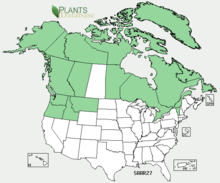Salix arctica,theArctic willow,is a tiny creepingwillow(familySalicaceae). It is adapted to survive in Arctic conditions, specifically tundras.
| Arctic willow | |
|---|---|

| |
| Arctic willow in Glacier National Park | |
| Scientific classification | |
| Kingdom: | Plantae |
| Clade: | Tracheophytes |
| Clade: | Angiosperms |
| Clade: | Eudicots |
| Clade: | Rosids |
| Order: | Malpighiales |
| Family: | Salicaceae |
| Genus: | Salix |
| Species: | S. arctica
|
| Binomial name | |
| Salix arctica | |

| |
| North American territories | |
| Synonyms[1][2][3] | |
| |
Description
editS. arcticais typically a lowshrubgrowing to only 15 centimetres (6 inches) in height, rarely to 25 cm (10 in), although it may reach 50 cm (20 in) in height in thePacific Northwest.[4]It has round, shiny greenleaves1–4 cm (1⁄2–1+1⁄2in) long and6 cm (2+1⁄4in) broad; they are pubescent, with long, silky, silvery hairs. Like the rest of the willows, Arctic willow isdioecious,with male and femalecatkinson separate plants. As a result, the plant's appearance varies; the female catkins are red-coloured, while the male catkins are yellow-coloured.[5][6]
Despite its small size, it is a long-lived plant, growing extremely slowly in the severearctic climate;one in eastern Greenland was found to be 236 years old.[5]
HybridswithSalix arcticolaandSalix glaucaare known.[5]
Distribution and habitat
editThe Arctic willow grows intundra[7]and rockymoorland,and is thenorthernmostwoody plantin the world, occurring far above thetree lineto the northern limit of land on the north coast ofGreenland.Its distribution is circumpolar. It occurs in Canada in the mainland northern territories and in the Arctic Archipelago all the way up to Ellesmere Island alongside Greenland, and in northern Quebec and Labrador, as well as in northern Iceland, Fenno-Scandinavia, northern Russia and northern Alaska.
It also occurs further south inNorth Americaon high-altitudealpine tundra,south to theSierra NevadainCaliforniaand theRocky MountainsinNew Mexico.It also occurs inXin gian g,China.[8][5][9]
Ecology
editThe Arctic willow is a food source for several Arctic animals.Muskoxen,caribou,Arctic hares,andlemmingsall feed on the bark and twigs, while the buds are the main food source of therock ptarmigan.
It is the primaryhost plantand food source for the Arctic woolly bear moth (Gynaephora groenlandica).[10]
Uses
editBoth theInuitand theGwich’inmake use of this willow. Twigs are used as fuel, while the decayed flowers (suputiit) are mixed withmossand used as wicking in thekudlik.The plant was used for several medicinal purposes, such as relieving toothache, helping to stop bleeding, curingdiarrhoeaand indigestion, and as apoulticeon wounds.[11]
Both the Gwich’in and Inuit in theBathurst Inletarea were known to eat parts of the plant, which is high invitamin Cand tastes sweet.[11]One young leaf contains 7 to 10 times more vitamin C than an orange.[7]The inside of the young shoots (excluding the bark) can be eaten raw, including those found underground.[7]
References
edit- ^Tropicos
- ^The Plant List
- ^"Flora of the Canadian Arctic Archipelago – Salix arctica Pall".
- ^"Salix arctica"(PDF).February 2016.
- ^abcdSalicaceae of the Canadian Arctic Archipelago:Salix arcticaArchived14 March 2012 at theWayback Machine
- ^Jepson Flora:Salix arctica
- ^abcU.S. Department of the Army (2019).The Official U.S. Army Illustrated Guide to Edible Wild Plants.Guilford, CT:Lyons Press.p. 12.ISBN978-1-4930-4039-1.OCLC1043567121.
- ^"Salix arctica".Germplasm Resources Information Network.Agricultural Research Service,United States Department of Agriculture.Retrieved24 December2017.
- ^Flora Europaea:Salix arctica
- ^Kukal, Olga; Heinrich, Bernd; Duman, John G. (September 1988)."Behavioral Thermoregulation in the Freeze-Tolerant Arctic Caterpillar,Gynaephora groenlandica".Journal of Experimental Biology.138(1): 181–193.doi:10.1242/jeb.138.1.181.
- ^abFlora of the Canadian Arctic ArchipelagoArchived5 June 2011 at theWayback Machine,S.G. Aiken, M.J. Dallwitz, L.L. Consaul, C.L. McJannet, L.J. Gillespie, R.L. Boles, G.W. Argus, J.M. Gillett, P.J. Scott, R. Elven, M.C. LeBlanc, A.K. Brysting and H. Solstad. 1999 onwards. Flora of the Canadian Arctic Archipelago: Descriptions, Illustrations, Identification, and Information Retrieval. Version: 29 April 2003."Flora of the Canadian Arctic Archieplago - Contents".Archived fromthe originalon 3 March 2011.Retrieved26 October2017..
External links
edit- Media related toSalix arcticaat Wikimedia Commons
- Jepson Manual treatment –Salix arctica